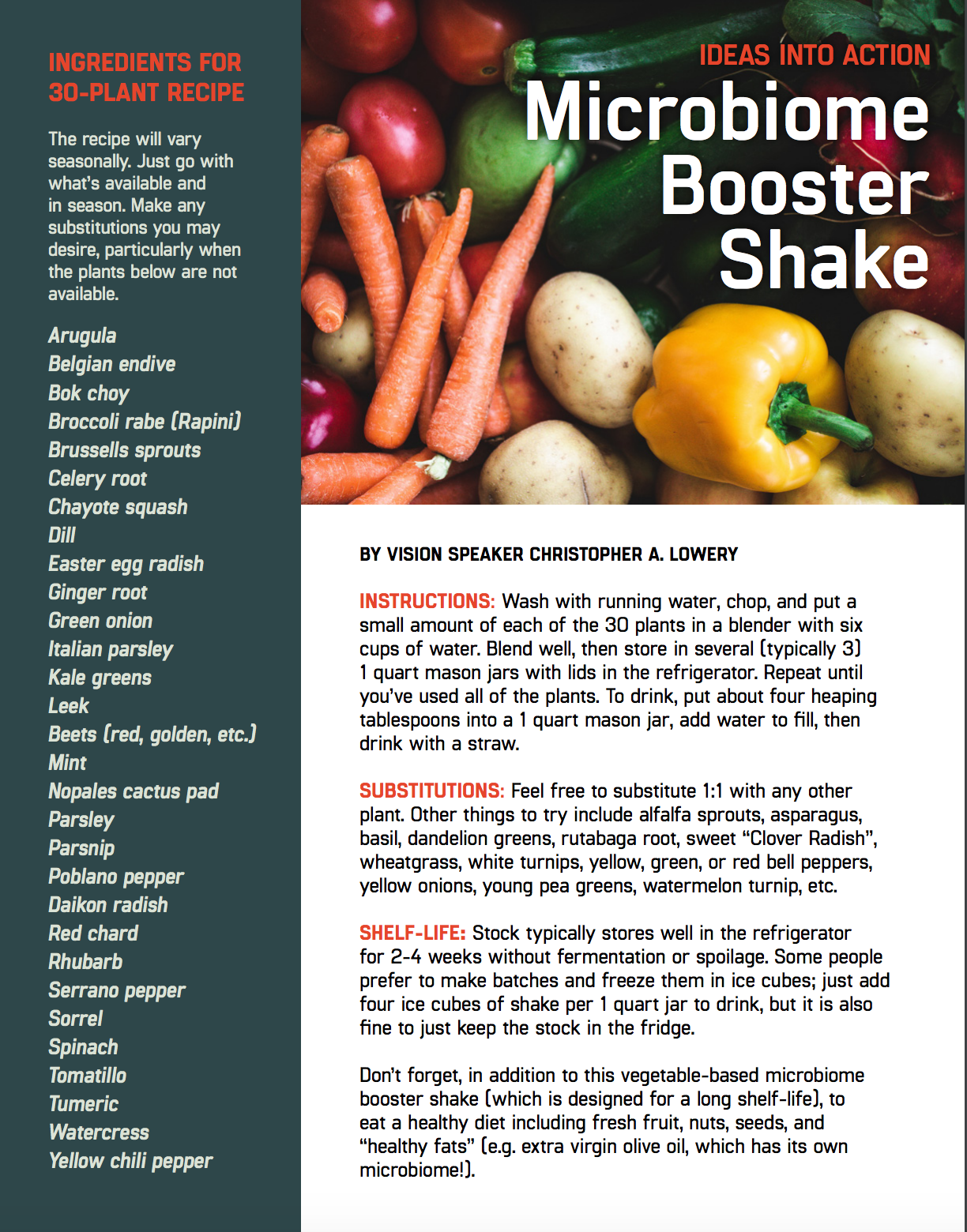Written by Anushka Bose
The word bacteria typically has a negative connotation and is often associated with devastating infections. In reality, some forms of bacteria can sometimes be good for you. In fact, it’s being clinically examined to treat mental health conditions. Last month I spoke with Dr. Christopher Lowry, an Associate Professor in the Department of Integrative Physiology and Center for Neuroscience at the University of Colorado Boulder, who talked about this idea in depth.
Dr. Lowry spoke at our TEDxMileHigh: Vision event, and his talk focused on how bacteria can provide us with various benefits for physical and mental health. Follow our discussion about how bacteria, found in food, nature, and in our municipal water supply can create a diverse gut microbiome that can reduce our inflammatory stress response.
Watch Chris Lowry’s TEDxMileHigh talk from TEDxMileHigh 2020 Vision Conference.
A Conversation with Dr. Chris Lowry on Gut Bacteria and Mental Health
Thank you so much for making time, Dr. Lowry. Your talk mentioned that some bacteria are our “old friends.” What exactly do you mean by that?
So, early mammals were small creatures that lived under the soil, which means for millions of years, they co-evolved with soil bacteria by breathing in and eating soil. They are our old friends in the sense that humans have co-evolved bacteria in our environment, and these “old friends” can communicate with our brains through the microbiome-gut-brain axis.
There are many benefits of bacteria that we can talk about, but my talk was promoting the idea that bacteria are useful in reducing the inappropriate inflammation in our bodies that shows up in a variety of stress-induced mental health conditions.
You studied the role of bacteria in military veterans with PTSD and mild traumatic brain injury at the VA Institute, right?
Yes, we partnered with Dr. Lisa Brenner at the Rocky Mountain MIRECC for Veteran Suicide Prevention, in 2016. We conducted clinical trials with U.S. military veterans with a diagnosis of PTSD and mild traumatic brain injury and gave them a live bacterium with anti-inflammatory properties daily for eight weeks.
We then brought them into the research laboratory and exposed them to a psychological stress paradigm called the Trier Social Stress Test. Those that received the anti-inflammatory bacterium showed reduced stress reactivity and a strong trend for reduced inflammation. Although larger studies are needed, it supports that idea that exposure to bacteria with anti-inflammatory properties can promote stress resilience.
How close are we to having this kind of research on the market?
It is within reach. The challenge is, with a drug treatment, there are regulatory requirements, as there should be. Which is why I am promoting a more accessible way of going about increasing exposures to bacteria for optimal health—one that just calls for a trip to the grocery store, drinking municipal water (if clean), and getting out in nature.
Let’s get into your 30-day plant-smoothie. Can you share the message you are trying to convey?
The microbiome booster shake is meant to diversify your gut microbiome. The idea is that the more diverse your microbiome is, the more resilient you are. Different types of plants provide different types of bacteria. Take spinach — it contains more than 800 different species of bacteria on and inside the plant.
Based on data from the American Gut Project, survey respondents were asked the question, “In an average week, how many different plant species do you eat?” Answers ranged from 0 to over 30 plants a week. Those who reported eating a higher diversity of plants had a more diverse gut microbiome. I thought, what would happen If I consumed 30 different plants a day? It would be similar to eating a whole forest, or farm, each day.
Your smoothie is just vegetables, not other plant-based foods. What’s the reason behind excluding fruits?
The smoothie I am suggesting is just vegetables, not fruits because I don’t want sugar that can ferment.

You also stress the idea of diversity, not just volume. Why does that matter?
You can think about the benefit of diversity in a few different ways. First, let’s look at an analogy. Which one do you think has more diversity, a wheat field, or the Amazon rainforest?
The Amazon.
Correct. So where is a fungal pathogen likely to take over?
The wheat field, right?
Yes. The wheat field, because it is a simple ecosystem.
The Amazonian rain forest is a complex ecosystem, and it is very difficult for a pathogen to get a foothold in a diverse ecosystem and out-compete every other bacterium that is there.
Secondly, most people don’t know this, but 80% of clinically used antibiotics come from soil bacteria. Soil bacteria make antibiotic molecules that kill the bad bacteria that cause disease in humans. The good and bad bacteria have been at war with each other for 3.5 billion years, sort of like an arms race.
So, imagine that you eat a plant that has 800 different species of bacteria in it, and some of them are making antibiotics, and releasing them, and now you have 1,000 different antibiotics in your gut. How successful would a pathogen be in invading your gut? Similar to the Amazon rainforest, the diversity in your gut microbiome would render the pathogens to have a low probability to succeed.
In 2018, Dr. Lowry partnered with Stefan Reber in Germany to test the idea that growing up on a farm may protect against inflammation and therefore the risk of stress-induced psychiatric disorders. This hypothesis is called the Farm Effect.
Can you explain the Farm Effect? How much of that is because people are not in cities, or how much is it that they are on a farm? Is it a specific variable, such as exposure to farm animals?
The Farm Effect is an idea by EriKa von Mutius in Germany that was developed based on the observation that if you grow up on a farm, it protects you from allergic asthma. They found the diverse microbial environment of a farm provided protection against airway inflammation.
So, [Stefan Reber and I] extended that by saying that if you grow up on a farm, you are protected from the impact of psychosocial stress. People who grow up in cities, for example, have a much-exaggerated immune response to psychosocial stress. And, this happens subconsciously; you really have no idea that your body is responding with inappropriate inflammation.
But to answer your question, we are planning a second study that will compare people who grow up on farms with and without farm animals. Is it proximity to animals, or is it just because it’s a farm? We’ll find out.
You touched on something very intriguing about stress. What if you are not consciously aware of your own stress? Has stress been embedded into us so deeply that we don’t recognize it?
Exactly, the stress response is very secretive. Even something like getting up and delivering a speech will activate the sympathetic nervous system, stress hormones, and the immune system, and even something as seemingly innocuous like that is stressful. You might not even recognize it, and you won’t know how the immune system is reacting.
What are some things people do or eat that minimize the health benefits that accompany healthy choices like your 30-day smoothie?
On what not to do—a big one is avoiding the overuse of antibiotics. They should only be used when medically necessary. Antibiotics are often used in meat production because they are using it to increase the rate of growth of the animals so that they gain weight faster.
The rule of thumb is that If you don’t need antibiotics for medical reasons, don’t take them.
On what to do—another way you can increase our exposure to good bacteria is drinking tap water. As long as your municipality has a healthy water supply, you should not avoid drinking tap water. There is a reason for it. I study mycobacteria, and particularly one specific bacterium isolated from mud in Uganda called Mycobacterium vaccae. There are many other mycobacteria. In tap water, the most abundant bacteria are mycobacteria.
So, by and large, if we have a healthy water supply, tap water is good for us?
Yes, one of the best sources for mycobacteria is tap water. You can buy ultra-processed water, and drink it from a bottle, but then you’re not getting exposed to the diverse ecosystem of bacteria that you find in municipal water supplies.
It is important to know if the municipality has a healthy water supply, and if your area has had any records of outbreaks of Nontuberculous Mycobacteria (NTM) infection. (Nontuberculous mycobacteria are commonly found in soil and water in many parts of the world).
NTM infection varies geographically, and many people come into contact with it. But it usually only causes an infection in individuals with underlying lung disease or a compromised immune system.
In addition to tap water, showers are also beneficial in getting exposed to good bacteria.
Showering is like exposing yourself to the rain; in showerheads, the most abundant bacteria are mycobacteria. Mycobacteria are resistant to chlorine. We chlorinate our tap water, which selects for the mycobacteria. The process of chlorinating water allows us to maintain access to mycobacteria for our own ecosystem.
So, the more we expose ourselves to environmental and dietary bacteria, the more resilient our bodies will be to negative bacteria?
Yes. You need the good guys to fight off the bad guys. The more exposure we have to good bacteria, the less likely that a pathogen will invade our bodies and cause harm.
Thank you so much for sharing. I hope your talk and research reaches a lot of people.
Thank you for allowing me to share!


















